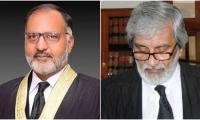The investigation into the attempt on the life of religious scholar and former judge Mufti Muhammad Taqi Usmani has not made much progress. The report of the forensic science laboratory (FSL) states that the weapons used in the attack do not match any previous criminal incident.
The Integrated Ballistics Identification System (commonly known as IBIS), which is considered a key investigative tool for high-profile cases, had stopped working because, according to the relevant officials, it was being upgraded, but now it is back online.
Police had collected at least 15 empty pistol shells from the crime scene and despatched them for ballistics cross-matching. The FSL report has been generated now after checking around 15,000 ballistic signatures of guns in the IBIS database.
“Two 9mm pistols were used in the assassination attempt, and the negative report suggests that the attackers had used new weapons,” claimed a senior officer. “A positive report would have been more helpful, but unfortunately, it could not happen.”
It is pertinent to note here that the ballistics cross-matching has only about 15,000 signatures to rely on, and a match is never 100 per cent, as a positive report means that there are at least 10 matches in the database that can be considered close.
Life attempt
Mufti Usmani, a respected religious scholar who served as a Federal Shariat Court judge from 1982 to 2002 and is currently the vice-president of the Darul Uloom Korangi, came under attack on March 22, when at least six assailants on three motorcycles targeted him in Gulshan-e-Iqbal.
Riding with his wife and two grandchildren, Mufti Usmani was on his way to the Baitul Mukarram Masjid to lead the Friday prayers, as is his weekly routine.
The religious scholar and his family members escaped the attack unharmed. But two of his security guards, including a policeman, lost their lives and two drivers suffered injuries. Investigators said that the attackers were divided into three groups: the first followed Mufti Usmani’s car from Korangi and the second followed him from Dalmia.
A video statement of Mufti Usmani’s driver has also surfaced. “Hazrat [Mufti Usmani] described the incident as it had actually happened,” he says in the video from his hospital bed. “But I have no idea about the actual number of assailants, as my only goal was to save Hazrat.”
Security matters
A five-member Wafaqul Madaris delegation led by Dr Muhammad Adil Khan met Sindh police chief IGP Dr Syed Kaleem Imam at the Central Police Office on Tuesday. Karachi police chief Additional IGP Dr Amir Shaikh and other senior police officers were also present on the occasion.
A police statement said that the IGP informed the delegation about the Mufti Usmani case investigation progress, and that the delegation expressed their satisfaction and assured the police of their complete cooperation.
A statement issued by the Wafaqul Madaris said that the IGP has appointed SSP Faisal Abdullah Chachar to look after the security matters of religious scholars and leaders, and to ensure that police officials are deployed for the scholars and leader after consulting with the Wafaqul Madaris.
A different MO
Four days have passed since the attack on Mufti Usmani, and it seems that the investigators have deviated from their modus operandi of investigating high-profile cases.
“In such incidents, cases are usually registered with the Counter Terrorism Department, which then conducts the investigation,” said a senior police investigator on the condition of anonymity.
“In this case, however, the FIR was registered at the local police station, and so only the police are carrying out the investigation. No inquiry committee comprising a pool of competent officers has been formed yet. Why is that?”
The case was registered on behalf of the state, despite the fact that the police have a private complainant in this major incident of terrorism, said the officer. The Karachi police chief, DIG-East Amir Farooqui and SSP-East Ghulam Azfar Mahesar seemed reluctant to comment on these observations when The News contacted them.
Investigation
Police said that they have conducted geo-fencing of the suspects’ phone calls and interrogated those who had contacted the callers. “Most of the suspected callers have been traced and questioned, while some of them are yet to be located,” said a source privy to the matter.
“We are also keeping an eye on the suspects who have entered or exited the country before and after the incident, and are also gathering the records of the suspicious travellers.”
A representational image of a police tape restricting an incident scene. — Reuters/FileA 40-year-old woman was...
Police escort Armaghan, prime suspect in Mustafa Amir murder case during an appearance before SHC on February 18,...
This footage shows a mob attacking an international food chain's restaurant located in Karachi on April 8, 2025. —...
Sindh Chief Minister Syed Murad Ali Shah presided over a meeting at the Chief Minister's House on April 10, 2025. —...
The representational image shows an ambulance. — AFP/FileThe mega city of Karachi witnessed a tragic and alarming...
View of huge fire flames rise from burning dumpers after traffic accident, at Nagan Chowrangi area in Karachi on April...







